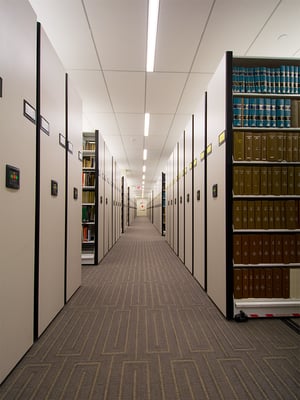- Minimize possibility of fire event
- Reduce effects of fire event
- Protect building, its occupants and contents.
- International Building Code (IBC) for storage facilities and buildings
- The National Fire Protection Association (NFPA) recommends automatic sprinkler protection for libraries and library collection storage
- The US National Archives & Records Administration (NARA) requires facilities housing federal records limit fire damage to a maximum 300 cu ft of records in a single fire event.
- Combustibility not only of the materials stored but also of the storage equipment
- Different considerations of mobile storage solutions versus static shelving against a wall
- Height of storage equipment in relation to ceiling and/or ceiling sprinkler systems
- Need for fire stops, which use storage equipment materials and/or create spaces to allow water penetration to better suppress a fire.
Standing by Product Design

High-bay storage minimizes the square footage required and offers a more efficient use of vertical space as well. Yet with the added height, storage planners often called for ceiling and intermediate height sprinkler solutions as fire protection. However, Spacesaver tested its high-bay product in a fire facility to gauge ceiling sprinklers alone success protecting documents, books, periodicals and other paper materials.
Tamping Out other Fire-Related Concerns
Of course some users are still concerned about putting in powered mobile systems as they contain electrical motors. Nevertheless, Spacesaver’s systems, in their entirety, are listed by Underwriters Laboratories (C-U.L.-US) and meet national standards for electrical safety.
When the University of South Carolina’s Law Library was moving into a new space with less square footage, Patterson Pope storage designers helped the university find the right solution to house its more than 300,000 volumes and regain valuable floor space to allow for collaborative work and student study tables and carrels. The new library’s nearly 8,000 square foot basement features a massive 27,000-linear ft.-plus electronic high-density mobile shelving unit with a number of safety features, including “Fire Park.”
Fire Park addresses a common concern with mobile storage carriers — that the units would impede sprinkler function. Connected to the building’s fire alarm system, the storage system is programmed to automatically open shelving units to even spacing if a fire alarm triggers. This spacing allows heat to rise and activate sprinklers and gives fire personnel clear views between the shelving units. It’s a feature that appealed to Stanford University’s athletic equipment managers when designing a storage facility for university athletes and the sports medicine department.
There were 96,800 non-residential building fires in the United States in 2016, for a combined loss of $2 billion, according to FEMA. The hope is that it won’t happen where you work. Still, anticipating the possibility and planning for fire protection and weighing fireproof storage options can make a difference. Let Patterson Pope help.













